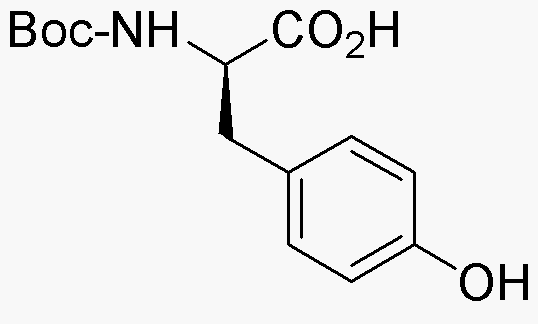Boc-D-tyrosine is widely utilized in research focused on:
- Peptide Synthesis: This compound serves as a protective group in the synthesis of peptides, allowing for the selective modification of amino acids without affecting the overall structure. This is particularly beneficial in pharmaceutical research where precise modifications are crucial.
- Drug Development: Boc-D-tyrosine is often used in the development of novel therapeutic agents, especially in creating compounds that target specific biological pathways. Its ability to enhance solubility can improve the bioavailability of drugs.
- Bioconjugation: In bioconjugation applications, Boc-D-tyrosine can be utilized to link biomolecules, such as proteins and antibodies, to drug molecules, enhancing their therapeutic efficacy and targeting capabilities.
- Research in Neuroscience: This compound is important in studies related to neurotransmitter systems, particularly in understanding the role of tyrosine derivatives in brain function and mental health.
- Cosmetic Formulations: Due to its properties, Boc-D-tyrosine is also explored in cosmetic chemistry for formulating products that promote skin health, leveraging its antioxidant potential.
Informations générales
Propriétés
Sécurité et réglementation
Applications
Boc-D-tyrosine is widely utilized in research focused on:
- Peptide Synthesis: This compound serves as a protective group in the synthesis of peptides, allowing for the selective modification of amino acids without affecting the overall structure. This is particularly beneficial in pharmaceutical research where precise modifications are crucial.
- Drug Development: Boc-D-tyrosine is often used in the development of novel therapeutic agents, especially in creating compounds that target specific biological pathways. Its ability to enhance solubility can improve the bioavailability of drugs.
- Bioconjugation: In bioconjugation applications, Boc-D-tyrosine can be utilized to link biomolecules, such as proteins and antibodies, to drug molecules, enhancing their therapeutic efficacy and targeting capabilities.
- Research in Neuroscience: This compound is important in studies related to neurotransmitter systems, particularly in understanding the role of tyrosine derivatives in brain function and mental health.
- Cosmetic Formulations: Due to its properties, Boc-D-tyrosine is also explored in cosmetic chemistry for formulating products that promote skin health, leveraging its antioxidant potential.
Documents
Fiches de données de sécurité (FDS)
La FDS fournit des informations de sécurité complètes sur la manipulation, le stockage et l’élimination du produit.
Spécifications du produit (PS)
Le PS fournit une description complète des propriétés du produit, notamment sa composition chimique, son état physique, sa pureté et les exigences de stockage. Il détaille également les plages de qualité acceptables et les applications prévues du produit.
Certificats d'analyse (COA)
Recherchez des certificats d'analyse (COA) en saisissant le numéro de lot du produit. Les numéros de lot et de lot se trouvent sur l'étiquette d'un produit, après les mots « Lot » ou « Lot de fabrication ».
Numéro de catalogue
Numéro de lot/série
Certificats d'origine (COO)
Ce certificat d'exploitation confirme le pays dans lequel le produit a été fabriqué, et détaille également les matériaux et composants utilisés et s'il est issu de sources naturelles, synthétiques ou autres sources spécifiques. Ce certificat peut être requis pour les douanes, le commerce et la conformité réglementaire.
Numéro de catalogue
Numéro de lot/série
Fiches de données de sécurité (FDS)
La FDS fournit des informations de sécurité complètes sur la manipulation, le stockage et l’élimination du produit.
DownloadSpécifications du produit (PS)
Le PS fournit une description complète des propriétés du produit, notamment sa composition chimique, son état physique, sa pureté et les exigences de stockage. Il détaille également les plages de qualité acceptables et les applications prévues du produit.
DownloadCertificats d'analyse (COA)
Recherchez des certificats d'analyse (COA) en saisissant le numéro de lot du produit. Les numéros de lot et de lot se trouvent sur l'étiquette d'un produit, après les mots « Lot » ou « Lot de fabrication ».
Numéro de catalogue
Numéro de lot/série
Certificats d'origine (COO)
Ce certificat d'exploitation confirme le pays dans lequel le produit a été fabriqué, et détaille également les matériaux et composants utilisés et s'il est issu de sources naturelles, synthétiques ou autres sources spécifiques. Ce certificat peut être requis pour les douanes, le commerce et la conformité réglementaire.


